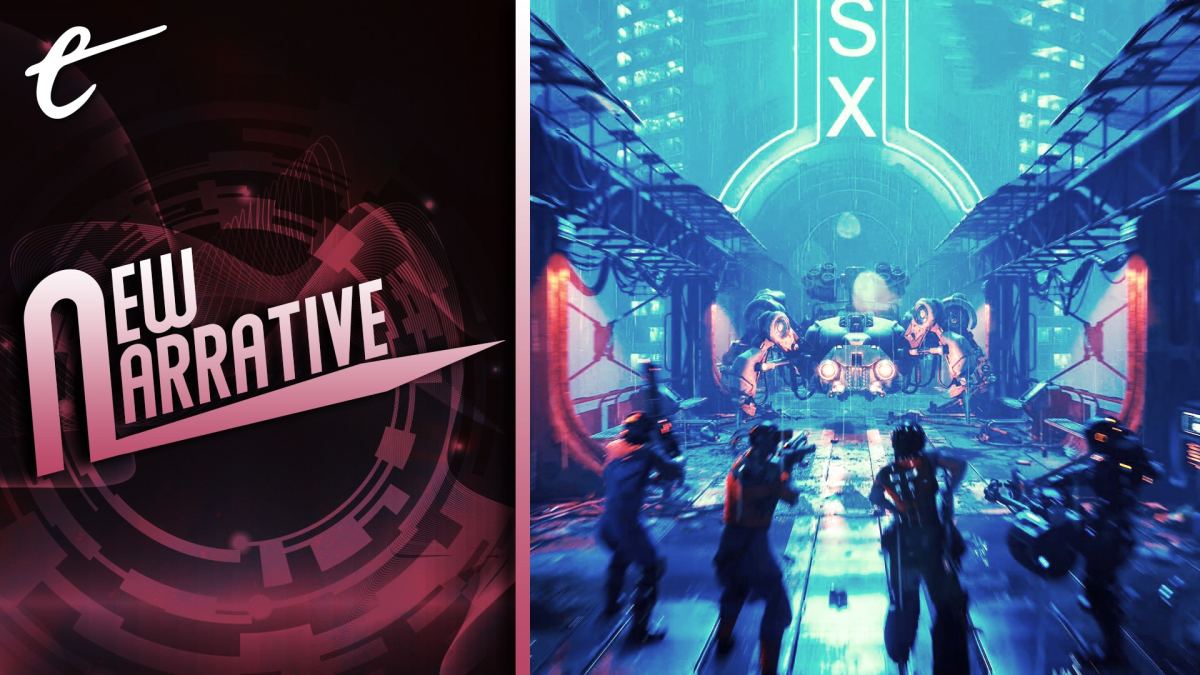There are two extremes to cyberpunk fiction. At one end, the slow, moody, contemplative storytelling and minimalist world-building seen in the likes of Blade Runner. At the other, the aggressive, fast-paced, in-your-face maximalism of Neal Stephenson’s Snow Crash and the like. The Ascent borrows liberally from both extremes and from every cyberpunk trope in-between. Its world almost forms a kind of meta-fiction: Just as it is cyberpunk tradition to fuse cultures into a melting pot of different languages, architectures, and styles, so The Ascent blends its many cyberpunk influences into a coherent whole.
This coherence is in large part due to The Ascent’s design. While the isometric presentation might recall Harebrained Schemes’ Shadowrun or Reikon Games’ Ruiner, the level of detail can easily go toe to toe with that of the biggest AAA blockbusters. The blocky arcology building of the titular Ascent Group recalls the slum tower at the heart of Dredd and the chunky aesthetics of Warhammer 40,000 or Metal Slug.
The arcology is packed quite literally to the rafters with cyberpunk clutter. Squat cars, drones, and spaceships reminiscent of the ponton-style air cars from The Fifth Element flit ceaselessly between multilingual neon signs, giant dancing holograms, and smoking chimneys. Humans, aliens, and robots throng walkways crammed with garish vending machines, shops, market stalls, parked or abandoned vehicles, computer terminals, and discarded rubbish. Taxis are only a creepy plastic face away from Arnold Schwarzenegger’s Martian cab ride in Total Recall.
Meanwhile, the metro is a reminder of one of the features apparently cut from Cyberpunk 2077. The outfits hint at Akira and Ghost in the Shell and fit over augmented body parts that could have been harvested from Deus Ex. There is even a building that looks suspiciously like the police station in Blade Runner.

The bird’s-eye perspective allows the environments to be presented like discrete dioramas of bustling activity. The camera sometimes leaves these details in the background — keeping them out of reach to lend literal and figurative depth to the world — and at other times brings the player into their midst via an unexpected lift or staircase. It feels like a succession of toy boxes, crafted with a fondness for ray-traced minutiae.
It’s a remarkable achievement, especially considering the size of the development team. And yet, despite all this activity, it never feels quite alive. Part of the problem is the minimalist approach to gameplay. It might be years of Path of Exile habits talking, but action RPGs stand or fall by their loot progression and skill trees — and The Ascent is surprisingly frugal in both areas.
It’s fun to punch enemies into clouds of bloody gore or watch them explode after being infected with a cyber virus, but there aren’t many other abilities on offer anyway. Likewise, weapon choice hit double figures only around eight hours into my playthrough, and although I did swap my armor periodically for the first couple of hours, I made do with two basic loadouts from then on.

The narrative could have been — and for a few excited moments I thought it was — a story about mutual aid in the face of corporate collapse, unbridled competition, and violently aggressive takeover. But it quickly devolved into the standard cyberpunk fare of jargon-happy bosses, edgelord hackers, and shadowy corporations that serve as bookends to bouts of indiscriminate violence.
It’s a strange contrast — these shallow stories and systems running in such a densely packed world — and it made me wonder if there is a problem with the cyberpunk genre more generally, rather than with The Ascent specifically. After all, it’s hardly the first time that cyberpunk has delivered style over substance.
At the time of William Gibson’s 1984 novel Neuromancer, or even The Matrix 15 years later, visions of a dystopian future run by megacorporations that profit by exploiting blurred boundaries between the private and the public, reality and cyberspace, and flesh and technology may have seemed like radical predictions. Today I would hardly be the first to suggest that these ideas are not only commonplace, but we might already be living them. To stay relevant, modern cyberpunk literature, like Paolo Bacigalupi’s The Windup Girl, has been forced to look further to a possible time of near total ecological and social collapse. It’s not difficult to see why one might wonder if cyberpunk has anything interesting left to say as a form of speculative fiction.

It would be easy to dismiss the genre in this way, if not for my original reference points. The success of Blade Runner, and the reason it has aged better than so much later cyberpunk, is partly down to its focus on themes that are timeless: the nature of humanity, empathy, desire, fear, compassion, and social division. They are framed by Ridley Scott’s and Philip K. Dick’s aesthetically arresting world of decay and corporate clutter, but they are not defined by it. As a result, the film is able to transcend its limitations — the anachronism of its 2019 “future” or its CRT screens, for example. It’s something Scott seemed to understand even better in The Director’s Cut and The Final Cut by removing Harrison Ford’s narration and letting the more subtle details, like the glint in Ford’s eyes or the swell of Vangelis’ “Blade Runner Blues,” hint at possibilities not made explicit in the script.
Similarly, Snow Crash might have a cyberspace, robot-patrolled microstates, Jet Set Radio-esque rollerblading, and the katana-wielding hacker Hiro Protagonist, but it also raises interesting questions about the relationship between natural and formal languages, about the evolution of language, and about the use of language as a means of control. It is, in other words, only partially in thrall to the tropes we most readily associate with cyberpunk.
In comparison, The Ascent is defined entirely by these cyberpunk tropes. In borrowing so freely from other cyberpunk reference points, it creates a world that is incredible to look at but that has little else to recommend it. It is like marveling at how the diorama has been made to move, rather than wondering what the movement might signify.






Published: Aug 11, 2021 4:00 PM UTC